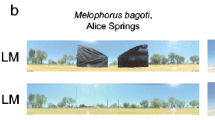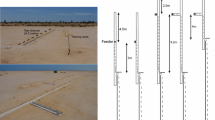Abstract
Many ant species travel large distances to find food, sometimes covering distances that are up to one million times their body length. Even when these foraging trips follow convoluted paths, the ants usually find their way back to their nest with precision (Wehner et al. in J Exp Biol 199:129–140, 1996). Ants have been shown to use both compass cues in the sky (pattern of polarised light) and landmarks on Earth to return to their nest. We present two experiments conducted on a solitary foraging ant: Melophorus bagoti in their natural habitat in the central Australian desert. Ants were trained and tested in situ. We tested foragers’ ability to exit a circular arena which provided an undifferentiated panorama. Artificial visual landmarks were located near a small exit. On tests in which path integration information was not available, foragers did not use artificial landmarks as beacons. Instead, they oriented in the learned exit direction, whether or not it pointed to the nest. We suggest that M. bagoti foragers learned a context-specific local vector when cued by the context of the circular arena. Our findings present the first evidence that M. bagoti foragers learn context-specific compass directions to chart their initial path home.







Similar content being viewed by others
References
Batschelet E (1981) Circular statistics in biology. Academic Press, NY
Bernard GD, Wehner R (1980) Intracellular optical physiology of the bee’s eye. I. Spectral sensitivity. J Comp Physiol A 137:193–203
Cheng K (2006) Arthropod navigation: ants, bees, crabs, spiders finding their way. In: Wasserman EA, Zentall TR (eds) Comparative cognition: experimental explorations of animal intelligence. Oxford University Press, NY, pp 189–209
Cheng K, Narendra A, Sommer S, Wehner R (2009) Traveling in clutter: navigation in the Central Australian desert ant Melophorus bagoti. Behav Process 80:261–268. doi:10.1016/j.beproc.2008.10.015
Collett M, Collett TS, Bisch S, Wehner R (1998) Local and global vectors in desert ant navigation. Nature 394:269–272
Franks NR, Hooper JW, Dornhaus A, Aukett PJ, Hayward AL, Berghoff SM (2007) Reconnaissance and latent learning in ants. Proc R Soc B 274:1505–1509. doi:10.1098/rspb.2007.0138
Fukushi T (2001) Homing in wood ants, Formica japonica: Use of the skyline panorama. J Exp Biol 204:2063–2072
Fukushi T, Wehner R (2004) Navigation in wood ants Formica japonica: context dependent use of landmarks. J Exp Biol 207:3431–3439. doi:10.1242/jeb.01159
Graham P, Cheng K (2009a) Which portion of the natural panorama is used for view-based navigation in the Australian desert ant? J Comp Physiol A 195:681–689. doi:10.1007/s00359-009-0443-6
Graham P, Cheng K (2009b) Ants use the panoramic skyline as a visual cue during navigation. Curr Biol 19:R935–R937. doi:10.1016/j.cub.2009.08.015
Graham P, Collett TS (2002) View-based navigation in insects: how wood ants (Formica rufa L.) look at and are guided by extended landmarks. J Exp Biol 205:2499–2509
Graham P, Collett TS (2006) Bi-directional route learning in wood ants. J Exp Biol 209:3677–3684. doi:10.1242/jeb.02414
Graham P, Fauria K, Collett TS (2003) The influence of beacon-aiming on the routes of wood ants. J Exp Biol 206:535–541. doi:10.1242/jeb.00115
Graham P, Durier V, Collett TS (2004) The binding and recall of snapshot memories in wood ants (Formica rufa L.). J Exp Biol 207:393–398. doi:10.1242/jeb.00771
Harris RA, Ibarra NH, Graham P, Collett TS (2005) Priming of visual route memories. Nature 438:302. doi:10.1038/438302a
Jammalamadaka SR, SenGupta A (2001) Topics in circular statistics. World Scientific, NJ
Kohler M, Wehner R (2005) Idiosyncratic route memories in desert ants, Melophorus bagoti: how do they interact with path integration vectors? Neurobiol Learn Mem 83:1–12. doi:10.1016/j.nlm.2004.05.011
Macquart D, Garnier L, Combe M, Beugnon G (2006) Ant navigation en route to the goal: signature routes facilitate way-finding of Gigantiops destructor. J Comp Physiol A 192:221–231. doi:10.1007/s00359-005-0064-7
Mardia KV (1972) Statistics of directional data. Academic Press, NY
McLeman MA, Pratt SC, Franks NR (2002) Navigation using visual landmarks by the ant Leptothorax albipennis. Insectes Soc 49:203–208. doi:0020-1812/02/030203-06
Menzel R, Blakers R (1976) Colour receptors in the bee eye—morphology and spectral sensitivity. J Comp Physiol A 175:457–475
Möller R (2002) Insects could exploit UV-green contrast for landmark navigation. J Theor Biol 214:619–631. doi:10.1006/jtbi.2001.2484
Narendra A (2007a) Homing strategies of the Australian desert ant Melophorus bagoti I. Proportional path integration takes the ant half-way home. J Exp Biol 210:1798–1803. doi:10.1242/jeb.02768
Narendra A (2007b) Homing strategies of the Australian desert ant Melophorus bagoti II. Interaction of the path integrator with visual cue information. J Exp Biol 210:1804–1812. doi:10.1242/jeb.02769
Narendra A, Si A, Sulikowski D, Cheng K (2007) Learning, retention and coding of nest-associated visual cues by the Australian desert ant, Melophorus bagoti. Behav Ecol Sociobiol 61:1543–1553. doi:10.1007/s00265-007-0386-2
Nicholson DJ, Judd PD, Cartwright BA, Collett TS (1999) Learning walks and landmark guidance in wood ants (Formica rufa). J Exp Biol 202:1831–1838
Tinbergen N (1972) The animal in its world. Harvard University Press, MA
Upton GJG, Fingleton B (1985) Spatial data analysis by example (vol. 2): categorical and directional data. Wiley, Toronto, ON
Vilela EF, Jaffě K, Howse PE (1987) Orientation in leaf-cutting ants (Formicidae: Attini). Anim Behav 35:1443–1453
Wehner R (1994) The polarization-vision project: championing organismic biology. Fortschritte der Zoologie (Progress in Zoology) 39:103–143
Wehner R (2003) Desert ant navigation: how miniature brains solve complex tasks. J Comp Physiol A 189:579–588. doi:10.1007/s00359-003-0431-1
Wehner R, Müller M (2006) The significance of direct sunlight and polarized skylight in the ant’s celestial system of navigation. Proc Nat Acad Sci USA 103:12575–12579. doi:10.1073/pnas.0604430103
Wehner R, Räber F (1979) Visual spatial memory in desert ants, Cataglyphis bicolor (Hymenoptera: Formicidae). Experientia 35:1569–1571
Wehner R, Srinivasan MV (1981) Searching behaviour of desert ants, genus Cataglyphis (Formicidae, Hymenoptera). J Comp Physiol A 142:315–338
Wehner R, Michel B, Antonsen P (1996) Visual navigation in insects: coupling of egocentric and geocentric information. J Exp Biol 199:129–140
Wystrach A, Beugnon G (2009) Ants learn geometry and features. Curr Biol 19:61–66. doi:10.1016/j.cub.2008.11.054
Zar JH (2009) Biostatistical analysis, 5th edn. Prentice Hall, NJ
Acknowledgments
This research was supported by a Natural Sciences and Engineering Research Council of Canada discovery grant to MLS and an Australian Research Council Discovery Project grant to KC (DP0770300). We would like to thank the Commonwealth Scientific and Industrial Research Organisation (CSIRO), Centre for Arid Zone Research, for allowing us to conduct field studies on their property. We would also like to thank the entire research team at the Alice Springs field station for their help with this project, especially Paul Graham, Antoine Wystrach, Sebastian Schwarz, and Patrick Schultheiss for their invaluable discussions and knowledge. We also thank Dawson Clary and the three anonymous reviewers for their clear and insightful comments that have greatly improved this manuscript. At the time they were conducted, these studies fully complied with the laws of Australia where they were performed.
Conflict of interest statement
The authors declare that they have no conflict of interest with the organizations that sponsored this research.
Author information
Authors and Affiliations
Corresponding author
Rights and permissions
About this article
Cite this article
Legge, E.L.G., Spetch, M.L. & Cheng, K. Not using the obvious: desert ants, Melophorus bagoti, learn local vectors but not beacons in an arena. Anim Cogn 13, 849–860 (2010). https://doi.org/10.1007/s10071-010-0333-x
Received:
Revised:
Accepted:
Published:
Issue Date:
DOI: https://doi.org/10.1007/s10071-010-0333-x




